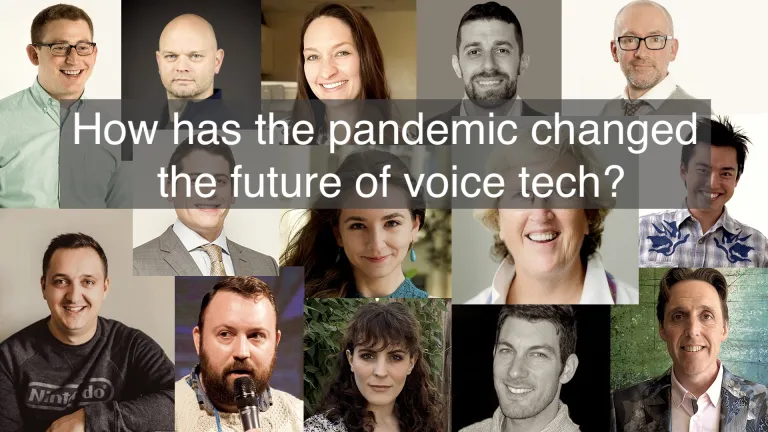In January 2020, we asked 14 global voice AI experts to make predictions about the future of voice: which industries would show the most growth and what innovations would lead us into the future? Six months later, we find ourselves in a very different world, distanced from friends, family, and colleagues, and wary about venturing outdoors or into public spaces.
As the pandemic swept across the globe, it became clear that touching shared surfaces and being in close proximity to others in public areas was not safe. Donning masks and wearing gloves, we continue to be hyper-aware of our surroundings and who and what we come into contact with in the pursuit of even the most basic of activities, including buying groceries or walking the dog.
Given the drastic changes to our world, we wanted to give the same 14 experts a chance to revisit, revise, rewrite, or double-down on their earlier predictions. Five months into a pandemic that shows no sign of slowing down, here is what leading executives, thought leaders, and other experts in the voice-first community have to say about the post-pandemic future of voice AI.
At the beginning of 2020, Carl was looking forward to a world where phone-zombies would be a thing of the past and edge technology would help solve some of the privacy concerns of voice AI users. He also predicted that hearables and wearables would be totally redefined by voice.
Here’s what Carl has to say today:
“We’ll continue to see consumer attention shift from the eyes to the ears. The four mega-trends of content marketing, podcasts, voice search and voice assistants will converge, and attract more marketing dollars to audio channels. New tools will democratize audio content creation to satisfy the increased demand.
As Google promotes audio to a first-class citizen in SERPs, businesses will clamour to create audio content. Discoverability of this new audio may become the killer app for voice assistants via voice search.”
Heidi Culbertson, CEO, Marvee
When asked, Heidi enthusiastically endorsed her original prediction.
“I absolutely double-down on my previous quote! 2020 success stories will come from heightened niche awareness and voice experiences driven by accessibility and domain context.
Our current environment has certainly shown the importance of voice as an ideal interface for access to information and connecting for every day needs. The need for access to critical health information, delivery services, education, fitness, social engagement (and much more) have all risen as top priorities, along with contextual design front of mind to ensure accessibility and solutions that do not inadvertently exclude any audience segment.”
Eric Turkington, VP, strategic partnerships, RAIN
“In January 2020, I predicted this year would see a sharp rise of “owned assistants,” where brands control their experiences (and data) more deeply than they can within 3P apps on Alexa and Google Assistant. Then COVID happened, and nearly every company faced significant turbulence and reprioritization of initiatives.
I remain bullish on the overall prediction that brands are going to ramp up owned assistant creation, across mobile apps, kiosks, drive throughs, cars, and more. A number of brands RAIN is working with across multiple industries have these assistants already underway (albeit slightly delayed due to COVID) or on their roadmaps for later this year. This year we’ve seen BBC release the Beeb beta in June, Spotify and Snap (with Houndify) have integrated voice into their mobile experience, and Cerence released the ARK Assistant platform for carmakers to customize voice assistants. It’s clear the momentum is building for voice-integration into digital touchpoints outside the ecosystems of mainstream big tech voice assistants.”
“I think my original quotes stand as they aren’t directly affected by COVID-19. All the same, neither have they come to pass, but I do still think they may.”
Keeping in mind that we are only halfway through 2020 (although it seems longer to most), here’s the quote that Peter Stewart still believes in, although it hasn’t happened yet.
“Voice-controlled AI will be more personalised in several different ways: it will become more mobile and more wearable, with sensors, GPS and microphones in items like spectacles and clothes, capturing data to detect our location. It will better anticipate our individual needs and it will understand our future needs from previous requests and link several suggestions into a seamless personalised experience, such as booking a cab, buying tickets and making reservations for a night out.”
In August, Keri’s predictions still align with her thinking in January that an audio strategy will be crucial in the coming months and years. Her new prediction includes new use cases and an imperative for personalization.
“With the changes due to the pandemic, I think what I mentioned back in January is still true. Although we’re seeing many businesses scale back in spending on branding and marketing which I think in many ways, the opposite should be done, we are seeing verticals like healthcare use voice now because they have to with the pandemic. You’re also seeing an increase of people using voice at home to ask for more information about COVID-19 as well as things like new recipes and cooking because more people are cooking at home now. The podcasting industry has grown tremendously in the last few months which means sonic branding has become important for businesses and Solopreneurs that have shows. So, whether it’s for listening to something that is fun and entertaining or to gather information on what’s going on in healthcare, it’s important to make sure that the user that’s interacting with the voice application enjoys the experience and gets the information they need.”
Mike Zagorsek, VP, product marketing, SoundHound Inc.
“In January, I predicted that every IoT-related industry would include companies announcing plans to release their own custom voice assistants using an independent platform. Given the increased public interest for safe and touchless interactions, along with recent announcements of custom voice assistants, I remain confident in the trajectory of voice technology through this year and beyond.”
Kane Simms, Co-Founder VUX World
Originally, Kane suggested that natural language processing (NLP) would take center stage in a year when organizations would “roll up their sleeves and get things done.” Here is how he sees the future of voice AI now:
“Those that are approaching it strategically are thinking broadly about how to apply conversational AI consistently across channels, which we predicted at the start of the year. The challenge is that it takes time to a) create and plan a holistic strategy and b) execute it widely, and so we’re not seeing many cross-channel strategies in-market today. Instead, many companies are trying to find their feet and plan for it properly. We all know that COVID-19 has brought an increase in confidence in using voice assistants, and so having a cross-channel strategy will be even more important over the next 12 months.”
James Poulter, CEO and founder Vixen Labs
My original quote:
“It’s all a bit chicken and egg: people are trying shopping with voice, so retailers are taking notice, and building those functionalities. But users can’t try out retail experiences which don’t exist. As a result, 2019 has seen voice shopping limited to specific industries and retailers, whereas 2020 will widen the playing field as users and developers explore together,”
My new one!
“When it comes to voice and shopping, COVID has changed everything. Whether that’s trying out products remotely from our homes, browsing in stores but not wanting to touch and pick up items, or simply trying to find out if a store is even open and for how long – all of these questions and use cases have been amplified greatly since COVID-19. I see voice and shopping as one of the great new frontiers as we look into 2021 and beyond. We need to find secure ways of giving both those shielding and those on the front lines opportunities to shop safely, whilst allowing them to immerse themselves in the brands that they know and love from home, via their smartphone headphones, or in their cars. Out-of-home advertising is set for a new revolution as we move to “invocation marketing” in the future, no longer focused on remembering complicated URLs or trying to get people to follow social handles. We can now use invocation marketing materials to drive shopping behaviours immediately through voice across every device and surface.”
Brandon Kaplan, founder and CEO, Skilled Creative
Brandon reflects on his original prediction with a keen sense of what is happening now as well as how things will likely continue—depending of course, on how people, brands, and the world at large decide to react to any unforeseen circumstance at any moment in time.
“If 2020 has taught us anything, predictions are to be taken with a grain of salt. Looking back however, I think we predicted the platform race fairly well. Platforms have continued to drive the majority of the momentum in the space. Amazon has continued to roll out wave after wave of new features, betas, and marketing efforts. Google has continued to work on pillar initiatives that have driven growth in IP functionality, smart home, storytelling, and gaming. Soundhound Inc. has led the way in bespoke voice initiatives with key players like Snap and Pandora, and a slew of other platform players have come to market or been acquired. What none of us could have predicted was quarantine, and we have seen usage skyrocket on some of our more prominent experiences with partners like Meredith Corp, Nutella, PepsiCo, etc. “Hands Free” is the magic phrase for voice scale. The combination in increased usage, and a massive batch of features from platforms will drive the next wave of voice growth in media, commerce, and utility. All of this is dependent upon brands and agencies continuing to invest in the space. There will likely be some consolidation in the coming months, but it will be up to platforms, brands, and agencies to work together to continue to grow the channel.”
Dennis Yang, co-founder, Dashbot
At the beginning of the year, Dennis focused on the growth of voice search as the easiest way to navigate apps and find information, and the rise of voice applications that allow name-free invocation. Nearly half a year, and a lot of changes later, he is still predicting the advancement of mobile apps and the rise of independent voice assistants.
“The buzz around audio-first apps, like Clubhouse, has highlighted the incredible power and intimacy of the medium. As a result, we’ll see a continued increase in investment into the audio-first ecosystem. Also, the desire to interact with applications in a more natural, conversational way will continue to grow, and is evidenced by Amazon’s own launch of their Alexa Conversations product. Finally, I’m really excited to see more applications add their own conversational interfaces, outside of the existing voice assistant ecosystems.”
Arte originally predicted that perhaps user acquisition and discovery and monetization would cease to be a barrier in an ecosystem that continued to evolve as a result of more enterprises realizing the value of voice assistants. In light of recent events, he sees that voice technology has an even greater role to play.
“In regards to Alexa Skills and Google Actions, I still believe user acquisition, discovery, and monetization are challenges. However, voice as an interface, in general, is even more important in today’s pandemic environment. Being able to call an elevator, open a door, check out at a store, or use an ATM via voice, without having to touch anything, would be incredibly useful and quite valuable. It will be interesting to see how voice is incorporated into more of these everyday interactions.”
Lauren Golembiewski, co-founder and CEO, Voxable
Lauren believes that the current crisis has strengthened her original prediction that the key to uncovering the value of voice lies in good conversational design.
“The pandemic has accelerated many businesses’ investment in voice interfaces as consumers seek touchless ways to interact with technology. There is an increased need for voice UX and design strategy underpinned by a well-defined process to create valuable and usable voice interactions. Many enterprise companies have begun to hire conversational designers while traditional UX designers, writers, and product people are seeking experience and learning opportunities that prepare them to transition into these conversational design roles. With so much investment in voice assistants and conversational design, companies will push the voice industry forward with increased innovation and operational maturity. Designers will democratize voice affordances by creating voice design systems or incorporating voice UI elements into existing design systems. As new voice assistants emerge to compete with incumbent platforms like Amazon Alexa and Google Assistant, designers must accommodate myriad voice and multimodal affordances.”
Dr. Joan Palmiter-Bajorek, head of conversational research and strategy, Versa
“Honestly reading back on these, much of my predictions haven’t changed to what I’m seeing now. What is different is how funds are being allocated at startups and such. But, there will be startups and companies who make it through this recession and I’m eager to be part of the ecosystem during and after it.”
Here’s what Joan had to say in January:
“In the new year, brands will realize the importance of voice search optimization and specifically design names of products to be best understood by speech recognition and natural language processing. Not only will marketing and branding experts be consulted, specialists in language content such as linguists and phoneticians will be hired from graduate programs and other consultancies. Visual puns and playing on words that worked visually will often not translate to the spoken word. A prime example is “Parton me” as a promotional code for the podcast, Dolly Parton’s America. While the joke is clever, it may seem less clever when the natural language processing and search query can’t find the right matches.”
Dave Kemp, creator and publisher, FuturEar
“At the start of the year, prior to the pandemic, my prediction was that media represented the most likely near-term killer use-case for voice-enabled devices, fueled by the rise of smart displays. With the advent of Alexa Quick Links and Google Action Links, I believe it’s now easier than ever for media companies, such as Discovery or Disney, to funnel their large followings on their affiliated social media channels, toward Alexa Skills/Google Actions. For example, I could see Food Network Kitchen using Instagram to share Alexa Quick Links for recipes, instructional videos, or cooking classes, so that fans on Instagram can easily transition from Instagram to their Echo Show or Fire TV for a more dynamic experience. It’s not hard to imagine Disney doing this—ESPN/Sportscenter too. I believe we’ll start to see very clever campaigns from some of the major media companies that utilize these new features to help expose users to different experiences enabled by devices powered by voice assistants. Ultimately, I believe this would help to grow media brands voice-enabled channels and expand the consumers’ perception on what voice enabled devices can do.”
In retrospect and looking forward
We kicked off 2020 with enthusiasm for a year filled with exciting events, innovation, and growth. In reality, most events have been either postponed or morphed into virtual meetings. In some cases, overall business growth has stalled, teams reduced, and budgets contracted. However, we’re encouraged by the optimism expressed by most of the experts we’ve talked to in the last 5 months.
In a recent video series, we asked industry experts, business leaders, and academics from a variety of backgrounds to weigh in on advice for brands and best practices for innovating and staying relevant during this difficult time. According to them, the companies that continue to innovate and look for new opportunities resulting from this crisis will be those that gain a competitive edge in their markets. See what these experts had to say in our Road to Recovery Guide and webinar.
In the coming months, we’ll be keeping our eye on the market and gather more trends and predictions for the future of voice AI. We’ll check in again after the new year to see which predictions have held true and which will once again need to be revisited.
If you’re a brand that wants to take advantage of new opportunities and innovate your way through a crisis, talk to us about how we can help you realize your voice-first goals, or try our voice AI platform with a free account.
Karen Scates is a storyteller with a passion for helping others through content. Argentine tango, good books and great wine round out Karen’s interests.









